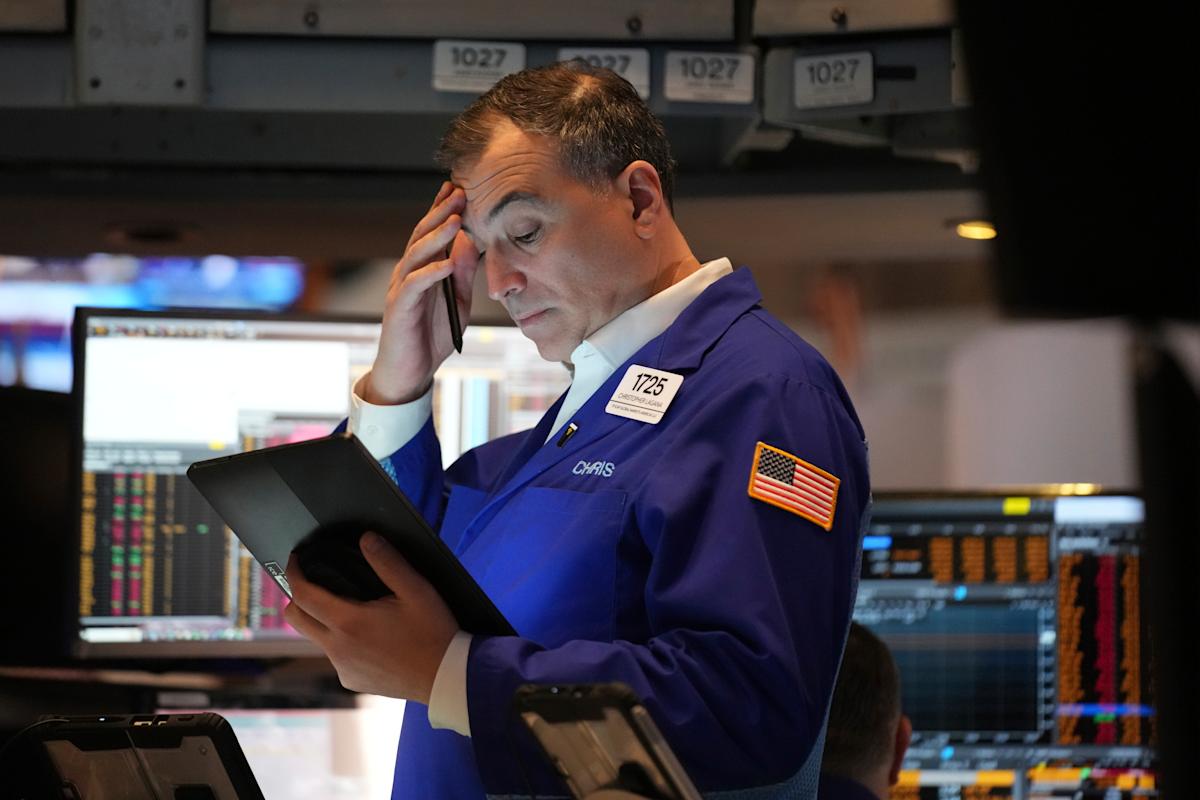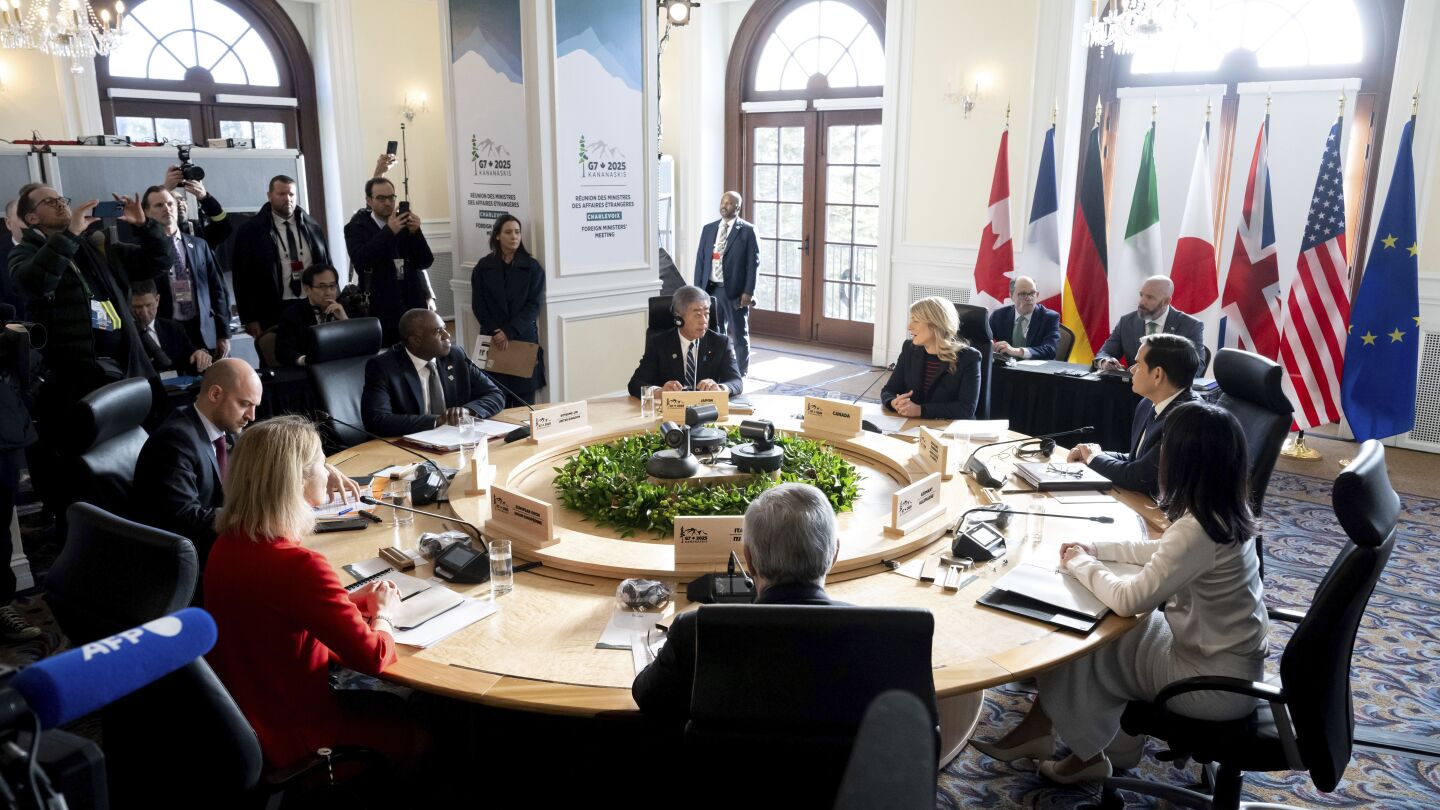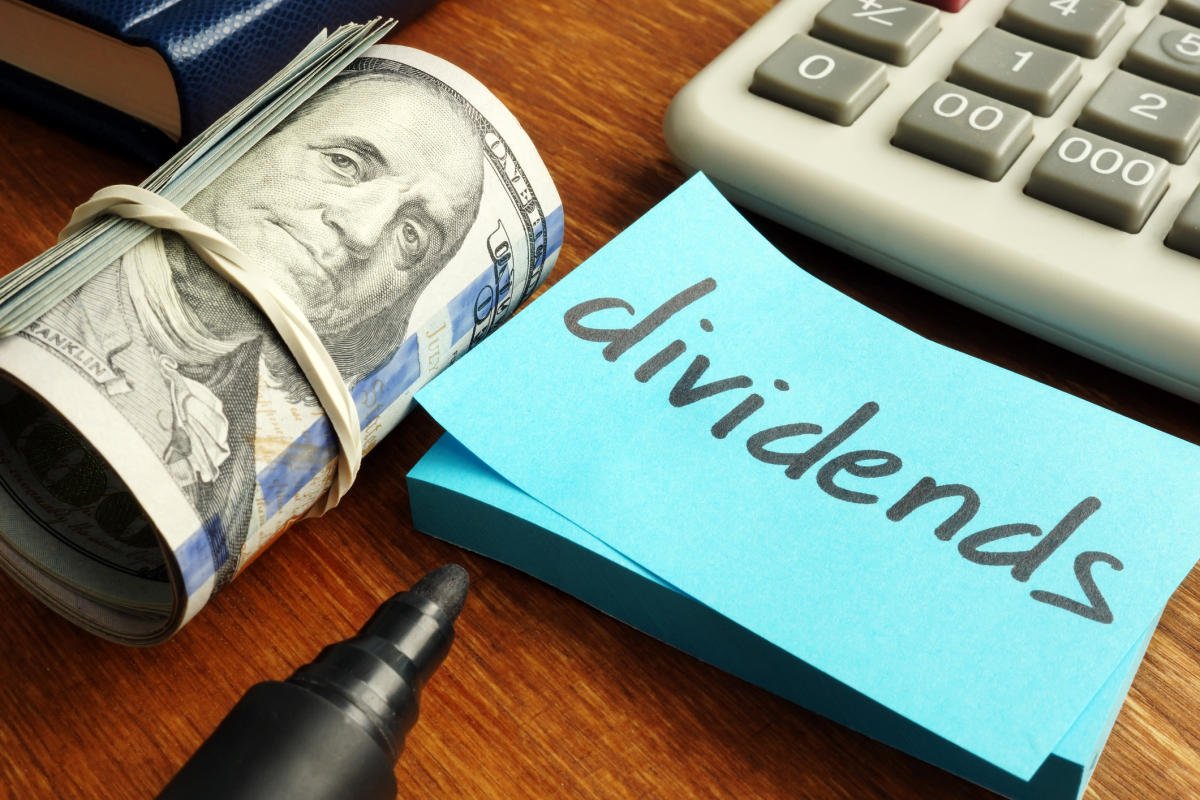Unlock stock picks and a broker-level newsfeed that powers Wall Street.
1 min read
In This Article:
US stocks closed mixed on Tuesday as investors cautiously counted down to President Trump’s highly anticipated “Liberation Day” rollout of sweeping new reciprocal tariffs.
The S&P 500 (^GSPC) rose about 0.4%, extending the gains the benchmark index secured on Monday, while the Dow Jones Industrial Average (^DJI) fell just below the flatline. The tech-heavy Nasdaq Composite (^IXIC) rebounded to close up around 0.9%.
SNP – Delayed Quote USD
^GSPC ^IXIC ^DJI
Markets are still in the dark as to what Trump will announce when he unveils his plans for like-for-like tariffs on Wednesday afternoon. The president’s multiple U-turns in tariff hints have kept investors turning in circles, with stocks jumping or sinking as prospects for more limited duties ebbed and rose.
The big question is whether the US will impose a blanket reciprocal tariff on all trading partners, or will tailor the rate levied to specific countries. What is pretty certain is the effective US tariff rate is likely to reach its highest level since at least the 1940s, analysts say — putting pressure on a US economy already grappling with slowing growth and stubborn inflation.
Read more: The latest on Trump’s tariffs
On the economic front, job openings hovered near a four-year low in February as the labor market showed continued signs of slow cooling. The data comes as investors closely watch for any signs that economic growth may be slowing further.
Meanwhile, separate data out Tuesday showed activity in the manufacturing sector slipped into contraction last month while costs continued to surge as suppliers weigh the impact of President Trump’s tariff policy.
LIVE 16 updates
-
S&P 500, Nasdaq end higher
US stocks closed mostly higher on Tuesday as investors brace for President Trump’s highly anticipated “Liberation Day” with sweeping reciprocal tariffs now on the table.
The S&P 500 (^GSPC) rose about 0.4%, extending the gains the benchmark index secured on Monday, while the Dow Jones Industrial Average (^DJI) fell just below the flatline. The tech-heavy Nasdaq Composite (^IXIC) rebounded to close up around 0.9%.
SNP – Delayed Quote USD
^GSPC ^IXIC ^DJI
-
How other countries respond to Trump’s tariffs could matter just as much for economic growth
All eyes are on President Trump’s tariff announcements expected on Wednesday. Recent reporting from several media outlets points to the possibility the President could slap “blanket” 20% tariffs on trading partners.
This in it of itself is expected to weigh on economic growth and boost inflation. Research from Yale Budget Lab shows that if 20% tariffs are enacted Americans could see a loss of buying power of $3,400-$4,200 per household, assuming no countermeasures from the Federal Reserve.
Yale Budget Lab also estimates tariffs would provide a long run lag on GDP of 0.32 percentage points. But should companies retaliate at the same level as the US tariffs, then the drag on long run growth would double to 0.62 percentage points.
The chart below shows how what could be announced in the coming hours or days from the US will be critical. But exactly how other countries respond could have just as much, if not more, of an impact on how tariffs actually impact the US economic growth story.
-
Foreign boycotts could register up to $83 billion hit to US GDP in 2025: Goldman Sachs
As Trump escalates his protectionist trade agenda, foreign citizens are taking matters into their own hands by boycotting US products and limiting tourism — a phenomenon that could significantly impact US growth and individual businesses.
In a note published on Monday, Goldman Sachs estimated foreign boycotts could amount to as much as 0.3% of domestic GDP, registering a hit of just over $83 billion based on current growth estimates of $27.7 trillion.
Goldman’s base case is closer to 0.1%, or nearly $28 billion.
“Most reports of boycotts of consumer goods have focused on Canada, where 53% of consumers claim to have started some form of boycott,” Goldman Sachs’ economics team led by Jan Hatzius said, citing a recent YouGov survey. “We expect a particularly large pullback in sales of American alcohol in Canada, since most of the provincial alcohol monopolies have removed US products from their shelves.”
Last month, Lawson Whiting, the CEO of Jack Daniel’s maker Brown-Forman (BF-B) said Canada’s decision to pull American-made spirits off its shelves was “worse than a tariff because it’s literally taking your sales away.”
On the travel side, Air Canada (AC.TO), which flies to the US more than any other Canadian competitor, said Monday that travel demand between the US and Canada is weak.
Bookings for trans-border flights between April and September are down 10% compared to the same period last year, according to company data compiled mid-March.
“Am I concerned? Yes. Definitely, I’m concerned,” Chairman Vagn Sørensen said.
-
Tesla sales tumble again in key European regions
Tesla (TSLA) registrations in many parts of Europe suffered in March as the quarter came to a close. Registrations are a proxy for official sales data, which Tesla may release as early as Wednesday, Yahoo Finance’s Pras Subramanian reports.
Here’s a look at March registrations for Tesla EVs in some European markets compared to the year prior:
Registrations in Spain, Portugal, and Italy bucked the trend and rose in March, according to Reuters, though they declined for the overall first quarter.
This data comes a week after the European Automobile Manufacturers’ Association (ACEA) reported Tesla’s registrations in the EU, UK, and European Free Trade Association fell 40.1% in February, to 16,888 EVs.
Still, shares of Tesla rose nearly 6% as of afternoon trade on Tuesday.
-
Q1 GDP growth now projected at -3.7%: Atlanta Fed
New economic data released on Tuesday showed elements of stagflation, with the ISM’s manufacturing index contracting for the first time this year while the prices paid index surged to the highest reading since June 2022, reflecting companies’ continuing cost increases.
Along with higher inflation, economists argue growth risks remain tilted to the downside, mostly due to the ripple effects of Trump’s tariff unknowns. Reciprocal levies are set to come as soon as Wednesday.
A potential softening of the labor market could also register a hit to GDP as job openings hover near four-year lows.
Currently, the Federal Reserve Bank of Atlanta’s GDPNow tracker, which analyzes incoming data points, signals negative growth of 3.7% in Q1, an escalation of the prior negative 2.8% reading.
In a press briefing on Tuesday, White House press secretary Karoline Leavitt told reporters, “April 2, 2025, will go down as one of the most important days in modern American history.”
“America will offer companies the lowest taxes, energy costs, regulations if they make their products right here in the United States and hire American workers.”
-
Johnson & Johnson stock falls 5% after judge rejects talc settlement
Johnson & Johnson stock (JNJ) fell 5% at the market opening and remained at that level through midday trading.
Late on Monday, a US bankruptcy court judge denied Johnson & Johnson’s third attempt to resolve the ongoing $10 billion talc litigation suit through bankruptcy.
Yahoo Finance’s Anjalee Khemlani reports that J&J has been fighting litigation from more than 60,000 plaintiffs since the early 2010s. The lawsuits allege the company’s baby powder and other talc products caused ovarian cancer, though Johnson & Johnson has repeatedly denied those allegations.
In a statement, J&J rebuffed the judge’s claim and said it would continue to fight the case.
-
Stagflation fears are rising
Stagflation has become the latest buzzword in financial markets as President Trump promises more tariffs, with reciprocal levies set to come as soon as Wednesday.
Concerns about stagflation, a bleak economic scenario in which growth stalls, inflation persists, and unemployment rises, have risen following a string of disappointing data releases, the Trump administration’s shifting trade narrative, and other policy unknowns, including recent efforts to cut government jobs from Elon Musk’s Department of Government Efficiency (DOGE).
“It’s really a shame that Trump is so willing to take a wrecking ball to the economy,” Ed Yardeni, president of Yardeni Research, wrote in a note to clients on Monday. “It has been very resilient over the past three years in the face of the tightening of monetary policy.”
Yardeni upped his probability of the US entering a stagflation period to 45% from the prior 35%, adding that the scenario includes the possibility of a shallow recession during the second half of this year.
The strategist pointed to several economic indicators, including faltering manufacturing activity and higher prices paid by purchasing managers, warning, “The higher inflation part of stagflation is almost a certainty.”
-
Newsmax stock soars as market cap leaps over $10 billion after IPO
Newsmax (NMAX) stock retreated Tuesday after soaring more than 120% earlier in the session.
Shares still climbed about 60%, extending the conservative cable news outlet’s massive 735% gain on Monday following its IPO.
Yahoo Finance’s Laura Bratton has the story:
-
US manufacturing slips into contraction as costs surge, pressured by Trump tariffs
Data out Tuesday showed activity in the manufacturing sector slipped into contraction and costs continued to surge as suppliers weighed the impact of President Trump’s tariff policy.
The Institute for Supply Management’s manufacturing PMI registered a reading of 49.0 in March, down from February’s 50.3 reading and below the 49.5 economists polled by Bloomberg had expected. Readings above 50 for this index indicate an expansion in activity, while readings below 50 indicate a contraction.
The prices paid index surged to 69.4, up from 62.4 the month prior and the highest reading since June 2022, reflecting companies’ continuing cost increases. Economists had expected a reading of 64.6.
Meanwhile, another reading on manufacturing activity out Tuesday also raised concerns over Trump’s tariff uncertainties. The final reading of S&P Global’s manufacturing PMI hit 50.2 in March, down from a strong 52.7 in February.
Chris Williamson, chief business economist at S&P Global Market Intelligence, said in the release, “The strong start to the year for US manufacturers has faltered in March.”
S&P said a “key concern” among manufacturers is the degree to which heightened uncertainty resulting from policy changes, notably tariffs, causes customers to cancel or delay spending, along with ripple effects from rising costs and deteriorating supply chains.
-
Job openings fall in February
Labor market data released Tuesday was weaker than expected as investors closely watch for any signs that economic growth may be slowing further.
New data from the Bureau of Labor Statistics showed 7.57 million jobs open at the end of February, a decrease from the 7.76 million seen in January. Job openings in February remained near a level last seen in early 2021.
The January figure was revised higher from the 7.74 million open jobs initially reported. Economists surveyed by Bloomberg had expected Tuesday’s report to show 7.66 million openings in February.
The Job Openings and Labor Turnover Survey (JOLTS) also showed that 5.4 million hires were made during the month, up slightly from the 5.39 million made during January. The hiring rate held flat at 3.4%. Also in Tuesday’s report, the quits rate, a sign of confidence among workers, fell to 2%, down from 2.1% the month prior.
Both the hiring and quits rates are hovering near decade lows.
-
Stocks fall as investors brace for ‘Liberation Day’
US stocks fell across the board on Tuesday, with all three major indexes retreating about 0.4% at the market open.
Investors are counting down to President Trump’s tariff-fueled “Liberation Day,” set for Wednesday, when sweeping new reciprocal tariffs will be announced.
DJI – Delayed Quote USD
^DJI ^IXIC ^GSPC
-
RBC rates Microsoft stock as a top pick
RBC Capital Markets analyst Rishi Jaluria added Microsoft (MSFT) to his “Top Picks” list on Tuesday. Jaluria has an Outperform rating and $500 price target on the stock.
Yahoo Finance’s Brian Sozzi reports:
-
Premarket trending tickers: Newsmax, J&J, Lucid, PVH
Newsmax (NMAX) shares rose 26% in premarket trading, continuing a searing rally for the stock as it heads into its second day of trading. The conservative media outlet’s initial public offering (IPO) on Monday drew a wave of retail investors and the stock was repeatedly halted for volatility as it soared 735%.
Johnson & Johnson (JNJ) stock fell 3.6% after a US judge rejected the company’s $10 billion proposal to resolve lawsuits linking baby powder and other talc products to ovarian cancer. It marked the third time Johnson & Johnson tried to avoid future claims through a bankruptcy strategy.
Lucid (LCID) shares were slightly higher in premarket trading after the company’s second product, the Gravity SUV, went on sale. Interim CEO Marc Winterhoff told Yahoo Finance’s Pras Subramanian that the EV maker is providing customers with an alternative to Tesla (TSLA), whose quarter was clouded by dampened demand, tariff concerns, and protests over CEO Elon Musk’s role in government. Still, Tesla stock rose more than 1% despite falling sales in Europe.
PVH (PVH) stock jumped 15% after the Calvin Klein and Tommy Hilfiger owner reported a sales outlook of “modest growth” that beat Wall Street’s expectations. Solid holiday sales helped stabilize the business, though executives noted it’s still contending with a tougher consumer backdrop.
-
Good morning. Here’s what’s happening today.
-
The key risks that drove the S&P 500’s worst first quarter in 3 years aren’t going away
-
Gold hits ATH in fourth consecutive day of record highs
Gold (GC=F) has continued a record run after setting a new high for the fourth day in a row on Tuesday. Concerns over the economic impact of President Donald Trump’s tariffs due on April 2 have pushed demand for safe-haven assets.
Reuters reports:



















